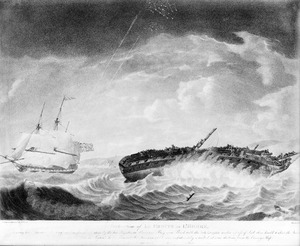General Goddard (1782 ship) facts for kids
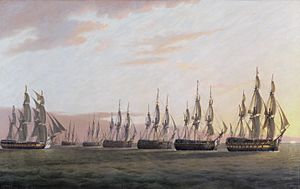
East Indiaman General Goddard with the Dutch Fleet, 15 June 1795, by Thomas Luny, c. 1796
|
|
Quick facts for kids History |
|
|---|---|
| Name | General Goddard |
| Namesake | General Thomas Wyndham Goddard, who played a major role in the First Anglo-Maratha War in 1780 |
| Owner |
|
| Builder | Randall |
| Launched | 30 January 1782 |
| Captured | 15 November 1799 |
| General characteristics | |
| Tons burthen | 79990⁄94 (bm) |
| Length |
|
| Beam | 35 ft 11 in (10.9 m) |
| Depth of hold | 14 ft 9 in (4.5 m) |
| Sail plan | Full-rigged ship |
| Complement |
|
| Armament |
|
The General Goddard was a special kind of ship called an East Indiaman. These ships were built to carry valuable goods for the Honourable East India Company (EIC). The EIC was a powerful British trading company.
The General Goddard was launched in 1782. It made six long trips to places like India and China. Later, after being sold, it sailed to the West Indies. There, in November 1799, the Spanish captured it.
One of the ship's most famous moments happened on its fifth voyage. On June 15, 1795, it helped capture seven Dutch East Indiamen. This was a big deal during a time of war.
Contents
What Was an East Indiaman?
East Indiamen were not just cargo ships. They were also built to defend themselves. They often traveled in groups called convoys. Sometimes, ships from the British Royal Navy would protect them.
Even without naval escorts, these ships were heavily armed. They carried many cannons. This helped them fight off pirates or enemy ships. During the French Revolutionary Wars, many East Indiamen, including General Goddard, carried special documents called letters of marque. These allowed them to capture enemy ships and their cargo.
First Voyages of the General Goddard
Voyage 1: India and Back (1782–1784)
The General Goddard began its first journey on September 11, 1782. Captain Thomas Foxall was in command. It sailed from Portsmouth, England, with other East Indiamen.
The ship reached Madras, India, in April 1783. It then visited other ports in India. On its way home, it stopped at St Helena. The General Goddard finally arrived back in England in October 1784.
Voyage 2: To China and Home (1785–1787)
Captain Thomas Foxall was still the commander for the second voyage. The General Goddard left England in December 1785. It sailed to Johanna in the Comoros Islands.
Then, it went to Madras, India. From there, the ship continued to China. It reached Whampoa in October 1786. The return trip included a stop at St Helena. The ship arrived back in England in August 1787.
Voyage 3: A Rough Return (1789–1790)
Captain Thomas Foxall led the third voyage. The General Goddard left England in February 1789. It reached Calcutta, India, in June.
On its way back, it stopped at Madras and St Helena. In May 1790, a problem occurred. The ship ran aground near the Isle of Wight in England. It was badly damaged and took on a lot of water. Despite this, it managed to reach England in June.
Voyage 4: New Captain, New Rules (1792–1793)
For its fourth trip, Captain Thomas Wakefield took command. William Taylor Money was his first officer. The ship left Portsmouth in February 1792. It sailed to Simons Bay and then to Diamond Harbour in India.
On the way home, it stopped at St Helena. The ship arrived back in England in June 1793. Around this time, war with France was starting. So, the General Goddard received its first letter of marque. This allowed it to capture enemy ships.
The Famous Fifth Voyage: Capturing a Dutch Fleet (1794–1795)
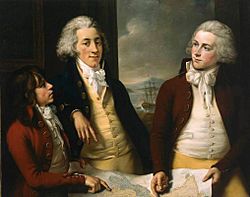
William Taylor Money became the captain of the General Goddard in October 1793. He received the ship's second letter of marque in January 1794.
The British government briefly held the General Goddard and other ships. They wanted to use them to attack Île de France (now Mauritius). But the plan was canceled. The ship was released in May 1794.
Captain Money then sailed the General Goddard from Portsmouth. It reached Madras in September and Diamond Harbour in October. On its way back, it stopped at St Helena in May 1795.
While at St Helena, news arrived. France had invaded the Netherlands. British ships were told to stop and hold Dutch vessels. Then, on June 2, a fast ship called Swallow arrived. It brought news that a group of Dutch East Indiamen had left the Cape of Good Hope. They were sailing towards the Netherlands.
The Chase Begins
On May 18, 1795, a convoy of sixteen Dutch East Indiamen left Table Bay. They had two escort ships. Bad weather forced eight of them back to the Cape. The other eight, with their escorts, continued sailing. Most of these reached neutral Norway.
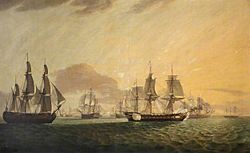
The eight Dutch ships that had returned to the Cape sailed again on May 22. These ships were not escorted. They soon met the British ships Sceptre, General Goddard, and Swallow near Saint Helena. Captain William Essington of the Sceptre convinced the governor of St Helena to let him use the EIC ships there. He formed a small fleet to catch the Dutch ships.
On June 3, Sceptre, General Goddard, and Swallow set out. Another EIC ship, Manship, also joined them. On June 7, they captured a "richly loaded" Dutch ship called Julie. Three days later, they captured the Hougly. The Swallow took the Hougly to St Helena.
The Capture of the Dutch Fleet
On the afternoon of June 14, Essington's fleet saw seven more ships. At 1 AM the next morning, the General Goddard sailed right through the Dutch fleet. The Dutch ships fired at it, but the General Goddard did not fire back.
Later that morning, after some shots were exchanged, the Dutch ships surrendered. Other British EIC ships, Busbridge and Asia, arrived and helped board the Dutch vessels. No one was hurt on either side. The British brought their captured ships to St Helena on June 17. Captain Money of the General Goddard was praised for his actions.
The captured Dutch ships were very valuable. Even though some were lost later, the prize money was a lot. Most of it went to the officers and crews of the British ships involved.
| Name | Launched | Tons burthen | Captain | Crew and passengers | Cargo value (Dutch Guilder) |
Fate |
|---|---|---|---|---|---|---|
| Dordwijk (Dordrecht) | 1787 for the Chamber of the VOC of Delft/Rotterdam | 800 | Hendrik Willem Ketjen | 40 | 89,176 | Sailed from Batavia 22 November 1794; after capture, damaged en route and broken up at Shannon |
| Hougly | 1788 | 1150 | Arnold Rogge | 139,517 | Abandoned and burnt 1 September after she became too leaky | |
| Vrouw Agatha (Lady Agatha) | Hired by the Chamber of the VOC of Amsterdam | 900 | Herman Pieter Murk | 115,960 | Sailed from Batavia on 22 November 1794; prize | |
| Mentor | 1789 at the VOC yard at Zeeland for the Chamber of the VOC at Zeeland | 560 | Ulke Barendsz | 50 | 61,361 | Prize |
| Surcheance | 1786 (purchased) | 768 | Christiaan Zummack | 81,527 | Sailed from Batavia on 22 November 1794; after capture lost on 5 September | |
| Zeelelie | 1789 | 1150 | Kornelis Adriaansz | 716,139 | Wrecked off the Scilly Islands on 26 September due to the fault of the English prizemaster. | |
| Alblasserdam | 1782 at the VOC shipyard at Zeeland for the Chamber of the VOC at Zeeland | 1150 | Klaas Keuken | 165 (one died on voyage between Batavia and the Cape, and 11 disembarked at the Cape | 457,491 | Prize |
| Meermin | 1782 at the VOC shipyard at Amsterdam for the Chamber of the VOC at Amsterdam | 500 | Gerard Ewoud Overbeek | 40 | Wine and hides from the Cape | Sailed from Batavia in 1795; prize |
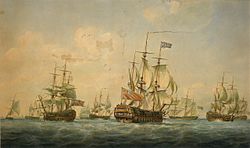
Final Voyages and Capture
Voyage 6: Expedition to Manila (1796–1798)
Captain Thomas Graham took command for the sixth voyage. The General Goddard left Portsmouth in April 1796. It sailed to Simons Bay and then to Madras.
The ship made several detours. This was because the British government was planning an attack on Manila. The EIC held several ships in India to support this plan. The General Goddard was one of them. The ship owners asked for money because of these delays. The captains also sued the EIC for their troubles. In 1800, the court awarded money to the captains and officers.
The General Goddard finally sailed home. It arrived back in England in August 1798. After this voyage, the ship was sold.
The General Goddard is Captured (1799)
A new owner bought the General Goddard. It became a supply ship, sailing between London and Jamaica. Captain John Bennett received a letter of marque in June 1799.
In the autumn of 1799, the General Goddard was part of a convoy. This group of ships was sailing to Jamaica. They were protected by British warships, HMS Crescent and HMS Calypso. On November 15, while near Puerto Rico, they met a small Spanish fleet.
The Spanish ships were larger and more powerful. The British captain tried to lead the Spanish away from the convoy. When that failed, he told the convoy to scatter. The Spanish ships chased the convoy. They managed to capture the General Goddard. It was the most valuable ship in the convoy.
The Spanish took the General Goddard to Havana. The ship was very useful to them. It was the largest British ship captured by the Spanish during that conflict. The General Goddard was likely sold for scrap metal in 1800.
Commemorating the Ship
On December 17, 1973, St Helena issued a special stamp. It honored the General Goddard's capture of the Dutch East Indiamen.


